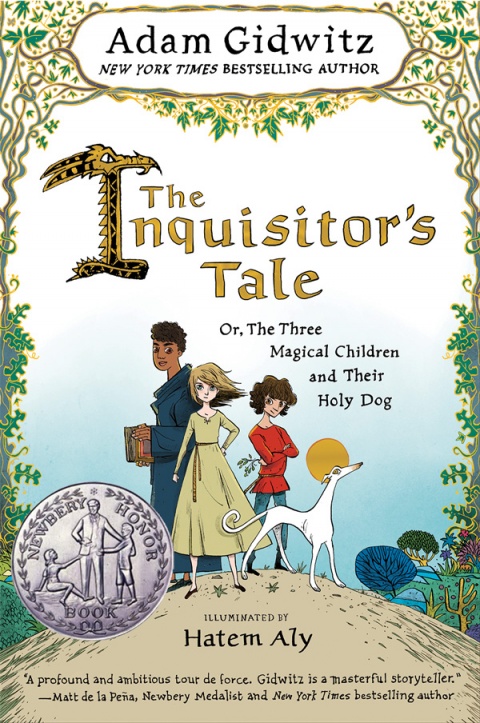Columbia College | Columbia University in the City of New York
Middle Ages Tale for Middle-Schoolers

Adam Gidwitz ’04 won a prestigious Newbery Honor in January for his book The Inquisitor’s Tale, Or, The Three Magical Children and Their Holy Dog (Dutton’s Children’s Books/Penguin Young Readers Group, $17.99), a quirky and funny middle-grade children’s novel that reads like The Canterbury Tales meets Game of Thrones, but for kids. According to Gidwitz, who specializes in what he calls “scary fairy tales,” this story of three “magical” children — Jeanne, William and Jacob — and Jeanne’s reincarnated “holy” greyhound, Gwenforte, “presents questions of belief and prejudice to young readers with historical context.”

Lauren Mancia ’05
Born in San Francisco and raised in Baltimore, Gidwitz came to Columbia as an “I-think-I-know-everything” kid, and was interested in the Core Curriculum because he valued a challenge. But a course in East Asian texts freshman year introduced him to Taoism and Buddhism and changed his outlook.
“I felt euphoric in my embrace of it; it was more fundamental than anything I had found,” he says. On a quest to learn “the truth about life,” Gidwitz considered further study in philosophy or religion before ultimately landing on English lit. “The truth is in literature,” he says. “If you describe something that communicates the truth without actually saying it explicitly, that’s your best shot at getting at it.”
As a break from his studies, Gidwitz would read children’s books for fun (“Now, ironically, I read adult fiction for fun,” he says). His hobby led him to take a children’s lit class that proved to be influential. After graduation, while teaching second-graders at Saint Ann’s School in Brooklyn, Gidwitz discovered he was good at storytelling and began writing out ideas. Though he wrote as an undergraduate and while earning a master’s at the Bank Street College of Education, he insists, “I learned a lot more from telling stories to kids than I ever did in a writing class.”
Gidwitz’s first three books were fairy tales; he says he intentionally made those characters two-dimensional so that young readers could put themselves into the story and experience the things the characters were experiencing. For this book, he wanted to create richer characters with fuller, more human lives.
He turned to history for inspiration. Gidwitz’s wife, Lauren Mancia ’05 (they met at the College in a Chaucer class), is a professor of medieval history at Brooklyn College; the couple travels to Europe regularly for her research and lived in France for a year. While there, Gidwitz dreamed up stories inspired by their surroundings and The Middle Ages that Mancia was studying. Some of his characters were actual people, like King Louis IX, some were based on real people, like Joan of Arc, and some were entirely made up (a fascinating Author’s Note at the end describes each in detail).
The narrative of the book was shaped by a real event Gidwitz learned about in 2012 while visiting the Museum of Jewish Art and History in Paris. A small plaque explained that in 1242, all the Talmuds of the Jews of France — about 20,000 handmade holy books — had been burned in front of them by the king and his mother, Blanche of Castile. The discovery “was like being kneed in the stomach,” Gidwitz says. “It took me a few days to feel OK again, like I had experienced a great loss.” The burning of the Talmuds in Paris forms the climax of the novel, after the magical children and their holy dog are pursued as heretics through France. Gidwitz’s experience of loss comes through as the characters are devastated by the destruction and a fatality at the pyre site.
The 13th century was a brutal time, and The Inquisitor’s Tale is an atypical children’s book in that it features intense death scenes and adult wisdom amidst farting dragons and other kid stuff. But Gidwitz believes “children are capable of a lot more than we give them credit for, like asking hard questions and imagining things that are beyond the scope of their world.”
The book’s illustrations, by Egyptian-born artist Hatem Aly, are drawn in a style reminiscent of Islamic art and alternate between enhancing the narrative and turning it on its ear — some of the images contradict what is written or have nothing at all to do with it. Gidwitz felt it was important to provide a Muslim perspective on a story that features Judaism and Christianity prominently. “I wanted a different voice, a different perspective and a different life experience around the edge of the pages,” he says.
It will be clear to readers of any age that the story’s themes of religious persecution and racial prejudice are all too relevant, and tolerance is a critical takeaway. “When I go to schools to read the book I talk about scapegoating,” Gidwitz says. “If young people read this, maybe they will see what’s going on in our world today through a different lens. I hope I wrote a book that will maybe make people better people.”
Issue Contents
Published three times a year by Columbia College for alumni, students, faculty, parents and friends.
Columbia Alumni Center
622 W. 113th St., MC 4530, 6th Fl.
New York, NY 10025
212-851-7852
cct@columbia.edu
Columbia Alumni Center
622 W. 113th St., MC 4530, 4th Fl.
New York, NY 10025
212-851-7488
ccalumni@columbia.edu

